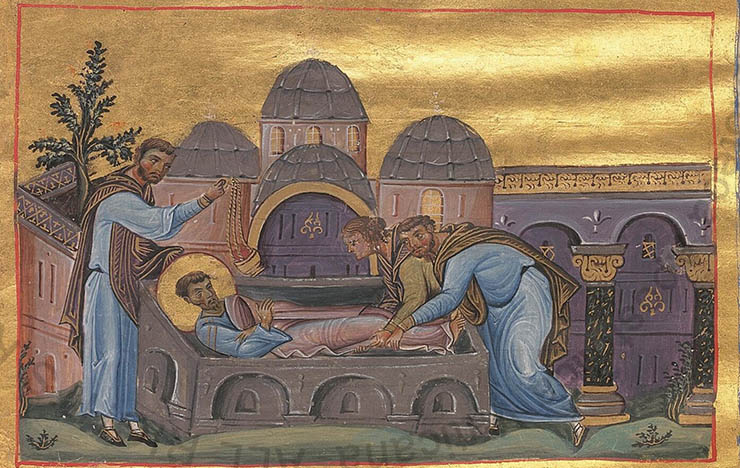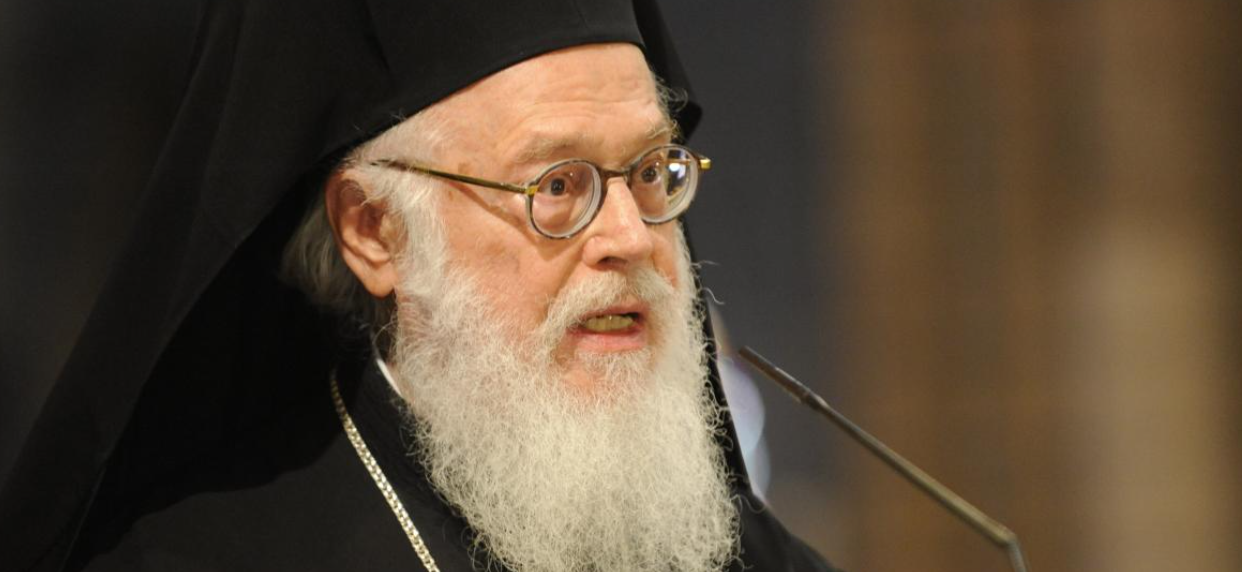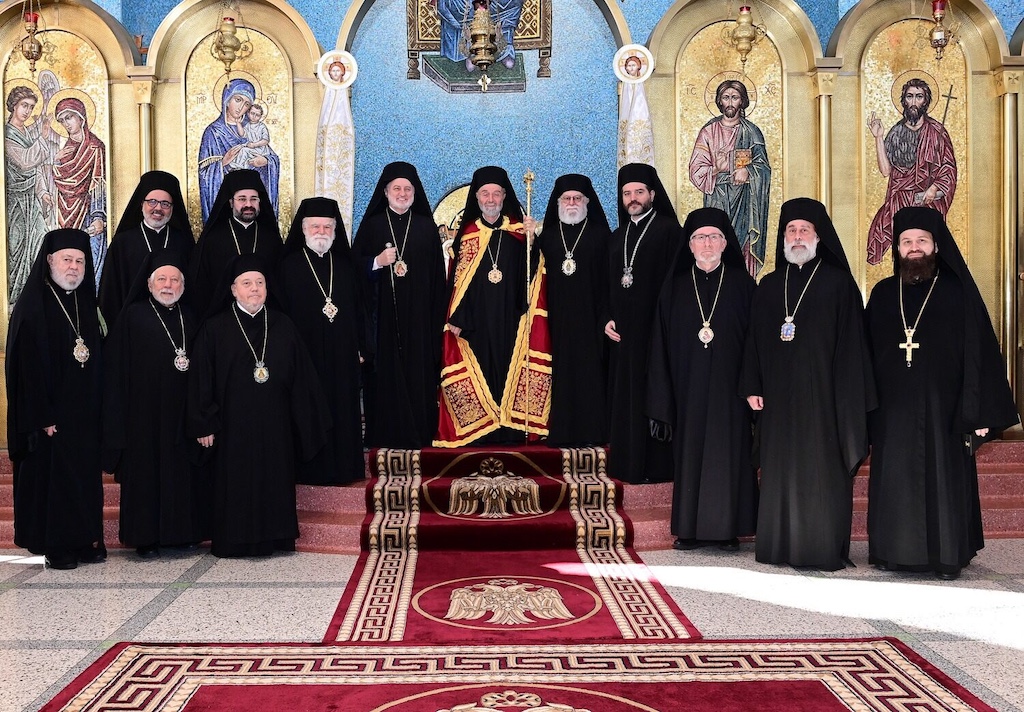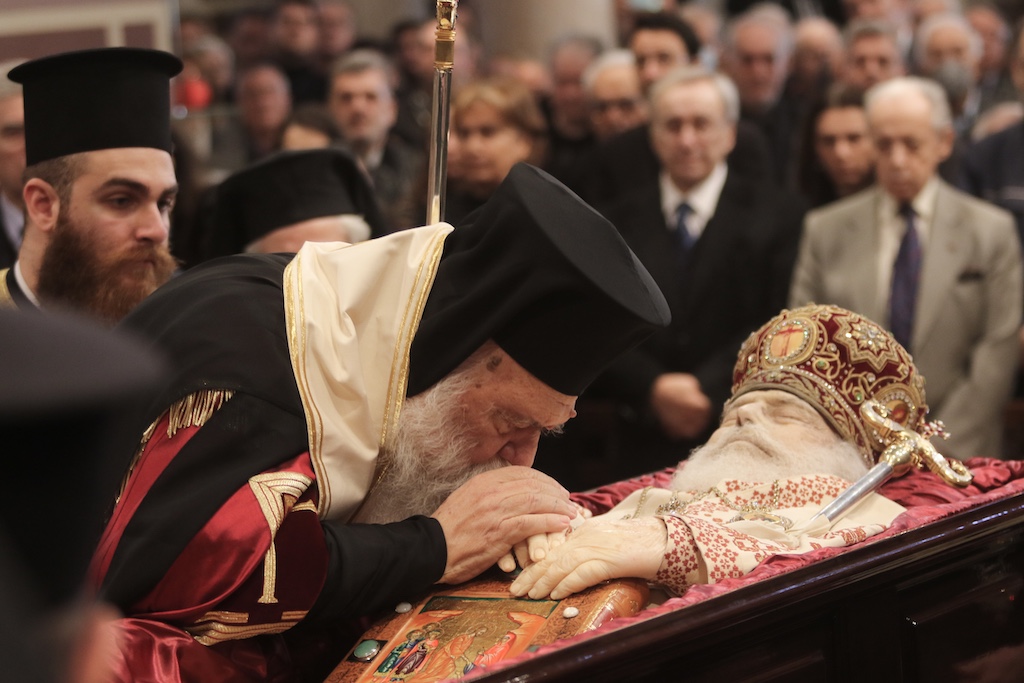Saint Theodore the Sykeote, Bishop of Anastasiopolis (22 April)


Saint Theodore the Sykeote was born in the mid-sixth century in the village of Sykeon, not far from the city of Anastasiopolis (in Galatia, Asia Minor), into a pious family. When his mother Maria conceived the Saint, she had a vision of a bright star shining over her womb. She consulted a clairvoyant Elder, who explained that this was the grace of God being poured forth upon her child.
When the boy reached the age of six, his mother presented him with a golden belt, since she wanted her son to become a soldier. That night the Holy Great Martyr George (April 23) appeared to Maria in a dream, and he told her not to seek a military career for her son, because the boy was destined to serve God. The Saint’s father, Cosmas, served as a messenger for Emperor Justinian the Great (527-565), but he died at a young age. The boy remained in the care of his mother Maria. His grandmother Elpidίa, his aunt Despoinίa, and his sister Blátta also lived with them.
In school, Saint Theodore displayed great apptitude in his studies, the most important being his rare gifts of reason and wisdom. He was quiet and mild, but he always knew how to calm his comrades, and he did not allow any fights or quarrels among them.
The pious Elder Stephen also lived at Maria’s house. At the age of eight, Saint Theodore started to imitate him, eating just a small morsel of bread in the evening during Great Lent. So that his mother would not force him to dine with everyone, the boy returned home from school only toward evening, after he had partaken of the Holy Mysteries with Elder Stephen. At Maria’s request, the teacher began sending him home to supper at the end of his lessons. Saint Theodore, however, ran to the church of the Great Martyr George, where the Saint appeared to him in the form of a young man, and escorted him into the church.
When Saint Theodore turned ten, he fell deathly ill. He was brought to the church of Saint John the Baptist and was placed before the altar. The boy was healed by two drops of water which fell from the face of the Savior in the dome of the temple. At this time the Great Martyr George began appearing to him at night, and also leading him to his own temple to pray until morning. His mother, fearing the dangers of the forest, urged her son not to go out at night.
Once, when the boy had already left, Maria followed him to the church, dragged him out by his hair, and tied him to his bed. That very night Saint George appeared to her in a dream, and commanded her not to hinder the child from going to church. Both Elpidίa and Despoinίa had the same vision. It was then that the women recognized Saint Theodore’s special calling, and they hindered him no longer. Even his little sister Blátta began to emulate him.
When he was twelve years old, the Saint had a dream in which he saw Christ on the Throne of Glory, Who told him, “Struggle, Theodore, so that you may obtain a perfect reward in the Kingdom of Heaven. From that time, Saint Theodore began to intensify his labors. He spent both the First Week of Great Lent and the Week of the Veneration of the Cross in complete silence.
The devil set out to destroy him. He appeared to the Saint in the form of his classmate Gerontius, and urged him to jump off a precipice, but Saint George rescued him.
One another occasion, Saint Theodore went into the desert to obtain the blessing of the Elder Glykérios. There was a terrible drought throughout the land, and the Elder said, “Child, let us pray to the Lord on bended knee, asking Him to send rain. Then we shall learn whether our prayers are pleasing to the Lord.” The Elder and his disciple prayed, and all at once it started to rain. Then the Elder told Saint Theodore that the grace of God was upon him, and blessed him to enter a Monastery when the time came.
When he was fourteen, Saint Theodore left home and lived near the church of the Great Martyr George. His mother brought him food, but Saint Theodore left everything on the stones by the church, eating only a single prosphoron each day. Even at such a young age, Saint Theodore was granted the gift of healing. Through his prayers a demon-possessed youth was restored to his right mind.
Saint Theodore fled human glory and withdrew into complete solitude. Under a large boulder not far from the church of Saint George, he dug a cave and persuaded a certain deacon to cover the entrance with earth, leaving a small opening for air. The deacon brought him bread and water, but he told no one where the Saint had hidden himself. For two years Saint Theodore lived in seclusion and complete quietude. His relatives mourned him, thinking that he had been devoured by wild beasts.
At last, the deacon finally revealed his secret, since he feared that Saint Theodore would perish in the narrow cave, and he also felt pity for his mother Maria. Saint Theodore was removed from the cave, barely alive. His mother wished to take her son home and nurse him back to health, but the Saint remained by the church of Saint George, and after several days he was completely well.
News of the young man’s exploits reached the local Bishop Theodosios, who ordained him to the diaconate, and later to the holy priesthood, even lthough the Saint was just seventeen years old. After a certain time had passed, Saint Theodore went to venerate the holy places in Jerusalem, and there at the Khozeba Lavra near the Jordan, he was tonsured as a monk.


When he returned to his native land, he continued to live near the church of Saint George. His grandmother Elpidίa, his sister Blátta, and his mother Maria entered a women’s monastery on the Saint’s advice. His aunt Despoinίa reposed there in peace.
The ascetical life of the young Hieromonk attracted people who were seeking salvation. The Saint tonsured the young man Epiphánios, and later on a pious woman, whom the Saint healed of her sickness, brought her son Philoúmenos to him. Then the virtuous young man John also came to him. Thus, the brethren gradually gathered around the Saint.
Saint Theodore continued his strenuous ascetical labors. At his request a blacksmith made him an iron cage without a roof, so narrow that it was scarcely possible to stand. In this cage Saint Theodore wore heavy chains from Holy Pascha until the Nativity of Christ. From the Baptism of the Lord until Holy Pascha he secluded himself in his cave, from which he emerged only for Church Services on Saturdays and Sundays. Throughout the forty-day Fast the Saint ate only greens and bread on Saturdays and Sundays.
Living in such a manner, he received from the Lord the power over wild animals. Bears and wolves came to him and took food from his hand. By the Saint’s prayers, those afflicted with leprosy were healed, and demons were cast out from entire districts. In the nearby village of Magatia, when locusts threatened the crops, people turned to Saint Theodore for help. He told them to go to the church. After he served the Divine Liturgy for them, the villagers returned home and learned that all the locusts had died during the Service.
When the military commander Maurikios was returning to Constantinople by way of Galatia after fighting the Persians, the Saint predicted that he would become Emperor. His words came true, and Emperor Maurikios (582-602) granted the Saint’s request: he sent bread to the Monastery each year for the multitude of people who were being fed there.
The small temple of Saint George could not accommodate all those who wanted to pray in it. Then through the Saint’s efforts, a beautiful new church was built. At that time, the Bishop of Anastasiopolis reposed. The people of the city asked Metropolitan Paul of Ancyra to install Saint Theodore as their bishop. So that the Saint would not resist, the Metropolitan’s messengers and the people of Anastasiopolis dragged him out of his cell by force and carried him into the city.
As a Hierarch, Saint Theodore labored much for the welfare of the Church, but his soul yearned for solitary communion with God. After several years he went again to venerate the holy places in Jerusalem. And there, concealing his identity, he settled at the Lavra of Saint Savva, where he lived in solitude from the Nativity of Christ until Pascha. Then the Great Martyr George told him to return to Anastasiopolis.
Unknown enemies tried to poison the Saint, but the Mother of God gave him three small pieces of grain. Saint Theodore ate them and remained unharmed. Weighed down by the burden of being a bishop, Saint Theodore asked Patriarch Kyriakos of Constantinople (595-606) to release him to his own Monastery so that he might celebrate the services there.
Saint Theodore was venerated as a Saint, even during his lifetime. His sanctity was so evident that when he offered the Eucharist, the grace of the Holy Spirit appeared as a radiant purple light, shining on the Holy Gifts. Once, when the Saint elevated the diskos with the Holy Lamb and said: “Holy things are for the holy,” the Holy Lamb floated up in the air, and then settled upon the diskos once more.
In one of the cities of Galatia, a terrible event occurred: during a Church procession, the wooden crosses being carried began to strike each other by themselves. As a result, Patriarch Thomas (March 21) summoned Saint Theodore, asking him the meaning of this terrible portent. Having the gift of foresight, Saint Theodore explained that this indicated coming misfortunes for the Church of God (he was speaking of the future heresy of the Iconoclasts). In his grief the holy Patriarch Thomas begged the Saint to pray that he would soon repose, so that he would not have to witness the coming catastrophe.
In the year 610 the holy Patriarch Thomas reposed after asking for Saint Theodore’s blessing. In that same year, Saint Theodore departed to the Lord.
Saint Theodore is also commemorated on June 15 (The Transfer of his relics).
Saint Theodore was born out of wedlock in Sykeon, a village of Galatia in Asia Minor. From his childhood, he was under the protection and guidance of the holy Great Martyr George, who often appeared to him, and was as it were his trainer in the hard ascetical discipline which he took upon himself all his life. After a pilgrimage to the Holy Land, he became a monk in his native Galatia. About 584 he was ordained Bishop of Anastasiopolis in Galatia, where he shepherded his flock for ten years. After this, he asked to be allowed to be relieved of the duties of governing the diocese. His request was granted but he was commanded to retain his rank as bishop. Saint Theodore was a great worker of miracles, and also received from God the power to cast out even the most obstinate demons, who called him “Iron-eater” because of his stern way of life. Having passed throughout many regions, worked numerous miracles, and strengthened the faithful in piety, he departed this life in 613.
Theodore was born in the village of Sykeon in Galatia, for which he was called the Sykeote. As a child of ten, he surrendered himself to strict fasting and all-night prayer after the model of Stephen, an elder who lived in his house. His mother, Maria, was a wealthy widow and intended to dedicate her son to the military profession. St. George appeared to her in a dream and informed her that Theodore was destined for the service of the King of Heaven and not a king of the earth. St. George appeared to Theodore many times, either to instruct him or to save him from certain dangers in which the evil demons had placed him. He also had several visions of the All-holy Theotokos [Mother of God].
Theodore’s asceticism surpassed in its severity that of all the living ascetics of his time. He mortified his body through hunger, thirst, iron chains, and standing at prayer all night. He did all of this in order to bind his soul with love for God and to make his soul the complete master over his body. In response to Theodore’s love, the merciful Lord responded with love. God bestowed upon him great power over evil spirits and over all of mankind’s diseases and afflictions.
He was famous everywhere as a wonder-working healer. Because of his purity and devotion, he was consecrated Bishop of Anastasiopolis against his will. He remained for eleven years at his episcopal duty, and then implored God to free him from this service in order to again dedicate himself to his beloved asceticism. After that, he returned to his monastery, where, in his old age, he rendered his soul to his Lord, for Whom he had willingly suffered much. He reposed at the beginning of the reign of Emperor Heraclius in about the year 613 A.D.
Apolytikion of Theodore of Sykeon
Fourth Tone
Since thou hadst been known from thy swaddling bands to be sanctified, and hadst been shown to be filled with graces, thou didst illuminate the world with miracles, and dist drive off the swarms of demons, O sacred minister Theodore; wherefore do thou beseech the Lord in our behalf.
Kontakion of Theodore of Sykeon
Third Tone
As thy fiery chariot, thou didst ascend on the virtues, O God-bearer, mounting up unto the dwellings of Heaven; and thou wast an Angel living on earth among men, and a man dancing for joy with the holy Angels. Hence, O Theodore, thou hast proved a godly vessel of awesome wonders and signs.
Source: oca.org / goarch.org / westserbdio.org




